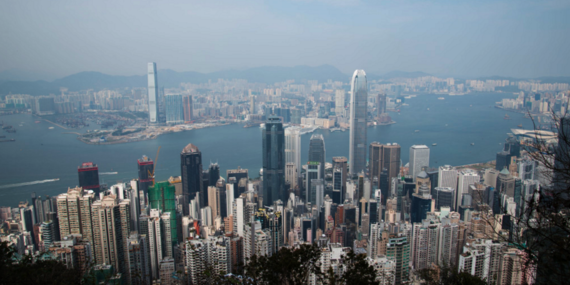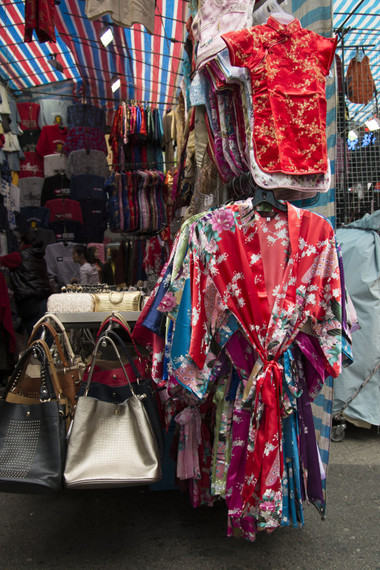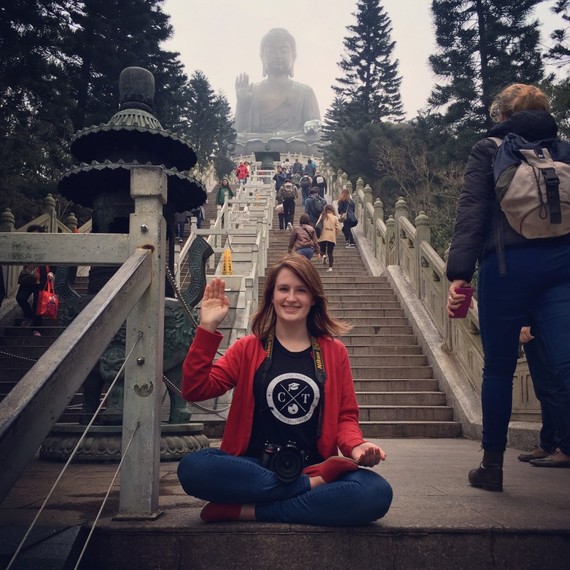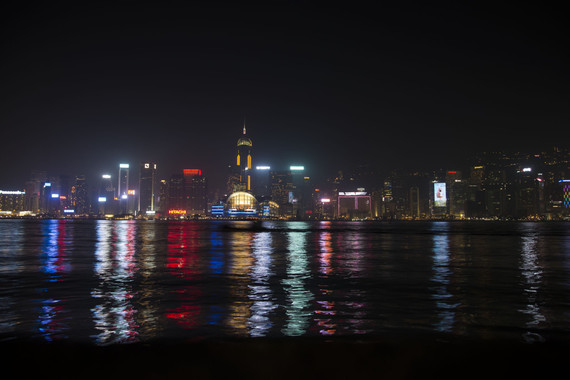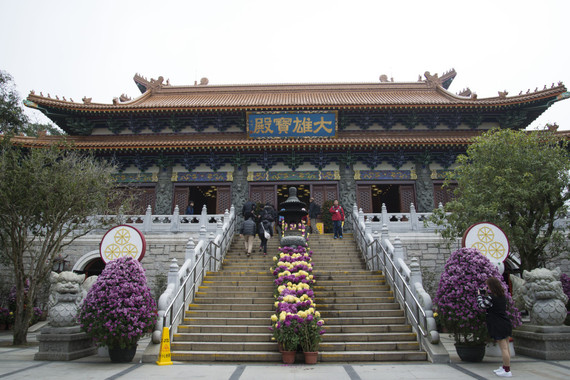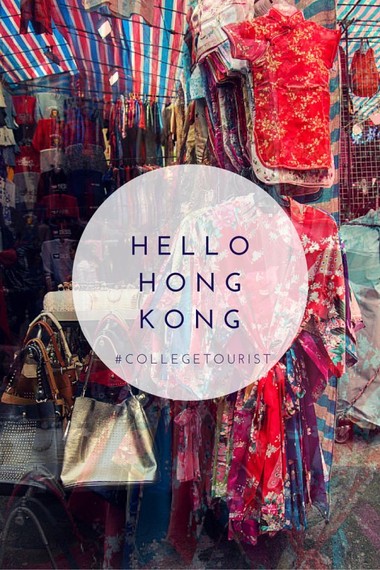It's almost hard to believe that it has been a month since I was wandering around Kowloon, haggling with vendors at the Ladies' Market in Mong Kok and swiping my Octopus card on the subway like a local in Hong Kong. Thanks to the ever-expanding educational and cultural partnership between Ohio University, Universität Leipzig, and now Hong Kong Baptist University, I was fortunate enough to spend 10 days halfway around the world working on transnational research project proposals, exploring a new city, and experiencing yet another way of life.
For those of you who are not familiar with the history of Hong Kong and who may be wondering why I don't say I went to China, here's the Reader's Digest version what you need/may want to know: In the mid-1800s, during the First Opium War, Hong Kong was ceded to the British by China as part of the two countries' path to end the conflict. According to the History Channel, in 1898 "Britain was granted an additional 99 years of rule over Hong Kong," which ended peaceably in 1997 when Hong Kong was turned back over to China. The one country, two systems policy is what is still in place today, and Hong Kong is classified as a "special administrative region" of China. This being said, there are plenty of ideological conflicts and in recent years there have been several demonstrations and protests related to some of these and balance of power/lack thereof in the region (the Umbrella Revolution/Occupy Central movement of 2014 and the Mong Kok Riot a couple weeks before I arrived, to name a couple). So, very short Reader's Digest version of history, but unless you're hitting the tarmac tomorrow, it's all you need to know right now.
Without further ado, here are a few of my recommendations for what not to miss should you find yourself in the City of Life:
FOOD & DRINK
I ate and drank at more places than I can count, but here are a few of my favorites:
- TAP, also known as The Ale Project, was one of my favorite hangouts in Mong Kok. This craft brewery is located a 10-minute walk from the Mong Kok East subway stop and serves dozens of beers from all over the world as well as local brews and some American food. If you're craving a burger and/or fries with real ketchup, make your way here. If you just want a beer, grab one then wander the streets to find another delicacy from a number of nearby vendors.
- Billy Boozers, a favorite hangout for some of the students at HKBU's Shaw Campus in Kowloon, is a little pub tucked away in the corner of a building next to the Hong Kong Baptist Hospital. Though this pub wasn't exactly my typical hangout, the dumplings sure were delicious!
- Lan Kwai Fong is an easy choice to get taste of Hong Kong's nightlife. As soon as you grow weary of one club's thumping base or overly-intoxicated inhabitants, you can step outside, turn a corner and find at least eight more bars packed with people. LKF draws a large international crowd, perhaps because of its proximity to Soho, an ex-pat occupied district. The drinks can be pricey at the trendier clubs, but Hong Kong allows open containers on the streets, so your group can grab a beer at one of many Seven Elevens and drink outside before heading inside a club for some beats.
- Kung Tak Lam Shanghai Vegetarian Cuisine, located a few minutes walk from Victoria Harbour, is a must-go for great food, a beautiful view, and a slightly different taste of Asia. Though it isn't the most college-student-budget-friendly, the food is to die for and KTL is a nice place to have a classy meal. Something I initially found odd and easily grew to love about vegetarian dishes in Hong Kong was that they tasted just like what they were mimicking. In the U.S., vegetarian options tend to range from salad to black bean burgers, but in Hong Kong, a menu will say "vegetarian chicken" or "vegetarian steak." This is not my grandma's version of vegetarian, which has on occasion involved hiding meat under veggies and pretending it isn't there, but is a combination of soybeans and other veggie-friendly foods with seasoning and probably a bit of magic that makes vegetarian cuisine look and taste like the real deal. Of course, you can also just get mushrooms or cheese or something that isn't faking it (Chinese mushrooms are my favorite!), but a "vegetarian [insert name of meat here]" dish is still quite tasty.
- Stanley Market is home to many a restaurant, but on the top floor of the main market building near the Stanley Market Plaza, there's a place that has the most wonderful cheese plate I could have asked for. Perhaps I was very hungry by the time I made it all the way down to the south side of Hong Kong Island, but I'm also a sucker for a glass of wine and a cheese plate.
-Near HKBU's Shaw Campus, near many subway stops, and especially in Mong Kok, you can find a variety of foods being sold from little shops that line the sidewalks. Over the course of my stay in Hong Kong, I had what I can only describe as bubble waffles, some mystery meet, ding ding candies (one of the ingredients is translated as "energy"), dragon beard candies, dumplings, and a whole host of other treats. Take a walk around wherever you're staying and you're sure to find something local to try.
Pro tip(s): to get ding ding candies and dragon beard candies, check out Sai Yeung Choi street in Mong Kok. OpenRice is a really great way to find food around you or in your destination, and is free (at least for iPhone users).
SHOPPING
It's pretty hard to go to a new place and not pick up a few souvenirs or a couple token items. For me, this happens in the form of scarves and magnets. I own scarves from every continent I've been to, if not every country (or in some cases, every city). Hong Kong is no exception: from touristy markets to chain stores with fashion modified to fit a particular culture to local malls where regular people go for their clothes, I spread what little wealth I had around.
- Stanley Market, located on the south side of Hong Kong Island, was a stop recommended to me by a friend who grew up in the area. It's a bit of a trek from Kowloon, but our hosts at HKBU spent a lot of time carting us around and showing us everything they could. From t-shirts and chachkies to beads and fabrics, anything you could want can be found in many of the markets around the city. I liked Stanley Market because it was by the water and a short walk away from a beach, near a temple that we visited, and out of the way from most tourists.
- The Ladies Market, perhaps one of Hong Kong's most famous markets (at least for tourists), is a couple blocks away from the Mong Kok subway station. I found a lot of the souvenirs I brought home while I was here - a purse for my sister, a wallet for my mom, scarves for...well, mostly me, chopsticks for my dad, etc. Bartering is expected, though if you go too low most shopkeepers will just turn around and walk away from you. I tend to be very firm and probably a bit mean when I barter, but that definitely hurt my chances with some products here.
- The Temple Street Night Market shopkeepers, on the other hand, were much more open to bartering and to meeting me where I wanted to be. There are also more restaurants around here, so you can sit down for a meal or just a snack before continuing your shopping adventure. At both Temple Street and the Ladies Market, you can find everything from chopsticks to headphones to hoverboards (not even kidding). As I had a couple extra days to meander by myself before the rest of the group arrived, I was able to visit both markets at least twice.
- The New Town Mall, if you're looking for something a little more commercial, is a nice place to shop. Though bartering is not expected nor always accepted there, I found a nice jacket that was just a little out of my price range. After trying it on (not everywhere lets you do this, by the way), I politely thanked the woman at the booth and told her it was too expensive. Ten minutes and some gesturing later, I left the mall with a new jacket for about 70 percent of the original price.
- H&M, and other brand names are also found in Hong Kong. Unlike Adidas, which had comparable prices to what I could find at home, H&M was unbelievably cheap in Hong Kong. A friend and I went tooling around "Times Square" (a shopping area modeled after NYC) and stumbled into some great deals (read: about $40 U.S. for what would probably run $140 or more at the mall near my hometown). So naturally, we did a little bit of "mainstream" shopping as well. I've also been to H&M in Germany, and I'm not sure why, but the selection (in my experience) tends to be better outside of the United States. Call me crazy, but some of my favorite pieces have come from chains like H&M in different countries.
Pro tip: Hitting up local malls or not-as-touristy markets will ensure that you (1) save some money and (2) have a unique experience to share. This being said, the touristy markets are also fun to check out.
EXPERIENCES
Now that you're well-fed and have loaded up on souvenirs, let's get to the important part: sightseeing. Though you'll certainly see a lot of Hong Kong (or at least Mong Kok, my favorite area) while going between restaurants, TAP, and the various markets, there are a few stops that must be made by anyone wishing to have a full experience. Or at least, have an experience like mine. Even if these don't all work out for you, just walking around and exploring can turn into an adventure itself.
- Lantau Island: If you can find your way to the Tung Chung subway stop, take a cable car through the clouds to Ngong Ping Village. There are also busses, but they take longer and the cable car ride is much more exciting anyway (unless you're afraid of heights, then definitely take the bus). In the village, you can see the Tian Tan Buddha (aka the "Big Buddha"), the Po Lin Monastery, dine at one of the restaurants there, and buy overpriced souvenirs. There are tours, but I found that it was easier to just get up very early and take my time having the experience I wanted to have.
- Cantonese Opera: The english subtitles are a bit off and you may suffer from acute hearing loss, but if you're looking to spend an evening and a chunk of change seeing something very traditional, this is certainly one way to do it. I'm pretty sure we brought the average age in the room down by about 30 years. And don't expect the audience to sit still with their phones silenced - the woman next to me answered a call halfway through the second half and was on the phone for a good 10 minutes. It isn't for everyone, but the costumes are absolutely stunning.
- The longest outdoor escalator and walkway system in the world can be found in Hong Kong. Head down to Soho to see (or ride) for yourself. While you're at it, try some of the local cuisine. There is food around here from all over the world. It's a bit expensive, as this is a fancier part of town, but it's also nice to just walk around. Exploring Soho is also a must-do experience, especially if you find yourself with a significant chunk of change in your pocket (if not, window shopping is almost as fun).
- The last place I thought I'd find myself in Hong Kong was at the horse races, but on the Wednesday night of my trip our whole group trekked to Happy Valley Racecourse to see the beasts in motion. The racecourse, found on the northern side of Hong Kong Island near "Times Square" costs HK $10 to enter (18+ only) and features musical groups, international cuisine, and of course the races pretty much every Wednesday night from September to July. Even if horse racing isn't your thing, it's still a pretty cool experience.
- Something I did expect and was very much looking forward to on this trip was a kung fu class that our hosts from HKBU arranged for us to attend. Over the course of almost three hours, we had the chance to learn a bit about the history of kung fu, learn how to effectively block (and punch!) our partners, practice standing meditation (which is way harder than it sounds), and I even had a chance to try my hand in the ring (I got punched in the face). Our class took place in a building in the Kwun Tong Industrial District that I highly doubt I'd be able to find again on my own. Even so, it was a really cool experience.
- The students we met and worked with while in Hong Kong were all very open and encouraged us to join them for their out-of-school activities. One new friend even invited my friend and I to her birthday party, which of course we went to. Unlike singing karaoke in front of a bunch of strangers in a bar in the U.S., in Hong Kong you can rent out a room and have all sorts of food and drink delivered for a fee of about HK $200 (U.S. $25) per person while you and your friends/family sing until you lose your voice. One Pacific Center in Kwun Tong has several floors of karaoke rooms available for reservations.
- Last but certainly not least, if you skip everything else on this list, a visit to both Victoria Peak and Victoria Harbour should be top priority. From the Peak, you can look over the northernmost part of Hong Kong Island and the southern tip of Kowloon (they meet at Victoria Harbour). There is about an hour-long walking trail that takes you around the area on the island with several open spaces with beautiful views of the Harbour and the financial district. If you don't feel like walking, one of the malls at the bus stop/Peak has a "lookout" point on its roof that you can pay a small fee to access. According to friends of mine who live in Hong Kong, the view is just as nice from the walking path if you want to save a couple bucks.
Pro tip: Check out local hashtags or Instagram/other social media accounts for activity inspiration. With everyone geotagging their images these days, it's easy to see something you're interested in then look for it.
GETTING AROUND
Now that I've given you a somewhat lengthy list of what to do and where to eat, you'll need to find a way to get there and how to pay for everything.
- Public transportation is readily available via the subway (called the "MTR") and a bus system. To take the subway or busses, all you need to do is purchase an Octopus Card at one of the stations and make sure you refill it when your balance is running low. You can get these at the airport (there's an express line that takes you all the way to Causeway Bay, which is a simple transfer away from almost any destination you could want) or most MTR stations. Some stores (Starbucks and TASTE, a grocery store in the city center) even let you pay with your Octopus card. There are also taxis, which can be a bit more expensive but are definitely convenient especially if you are not staying super close to an MTR station (I was about a 15 minute walk from Kowloon Tong MTR station).
Pro tip: Download the MTR app (available for both iPhone and Android). Even offline, the app can help you plan trips especially when you have to switch transit lines. It also gives a pretty accurate transit time estimate, and will tell you if you need to switch platforms in transit.
MONEY
Whenever my friends go abroad, I'm always asked about how I handle money abroad. Some people bring only cash to exchange; some only bring a card to use at an ATM. I have about a million tips and tricks that I have picked up from my own experiences all over the world, but there is no one way to do this.
- When I travel, I bring U.S. $100 in emergency cash (the bigger and newer the bill the better, aka a $50 or $100 from no earlier than 2006, as forex bureaus in some countries won't exchange smaller denominations or older bills) and my Charles Schwab debit card. I've been using Schwab since I moved to Ecuador for a semester in 2014, and I've always had a good experience. Customer service is helpful, and foreign transaction fees and ATM fees are paid for me (an added bonus!). In Hong Kong, I used a couple different ATMs and never had a problem. Just make sure to let your bank know when and where you'll be traveling. As always, split up your money in your luggage and make sure you keep track of your credit cards/cash/passport.
- If you're looking for an app/website to calculate foreign exchange rates, the one I use (both website and app form) when working on the YALI Connect Camps and now in my personal travels is Oanda Currency Converter. Don't forget about ATM, transaction fees, and other miscellaneous fees you may run into, but the app has helped me budget for travel on many trips.
Pro tip: Don't exchange money at an airport. You will almost certainly get ripped off with additional fees. Instead, use ATMs when you arrive at your destination. Taking out a larger chunk of change will minimize ATM/foreign transaction fees, then just keep some of your money somewhere safe (i.e. in the safe in your hotel room).
Have you studied abroad? Share your story with the College Tourist!
Follow us on Instagram @officialcollegetourist | Tag your photos #collegetourist.
Follow College Tourist on Twitter: www.twitter.com/collegetourist

